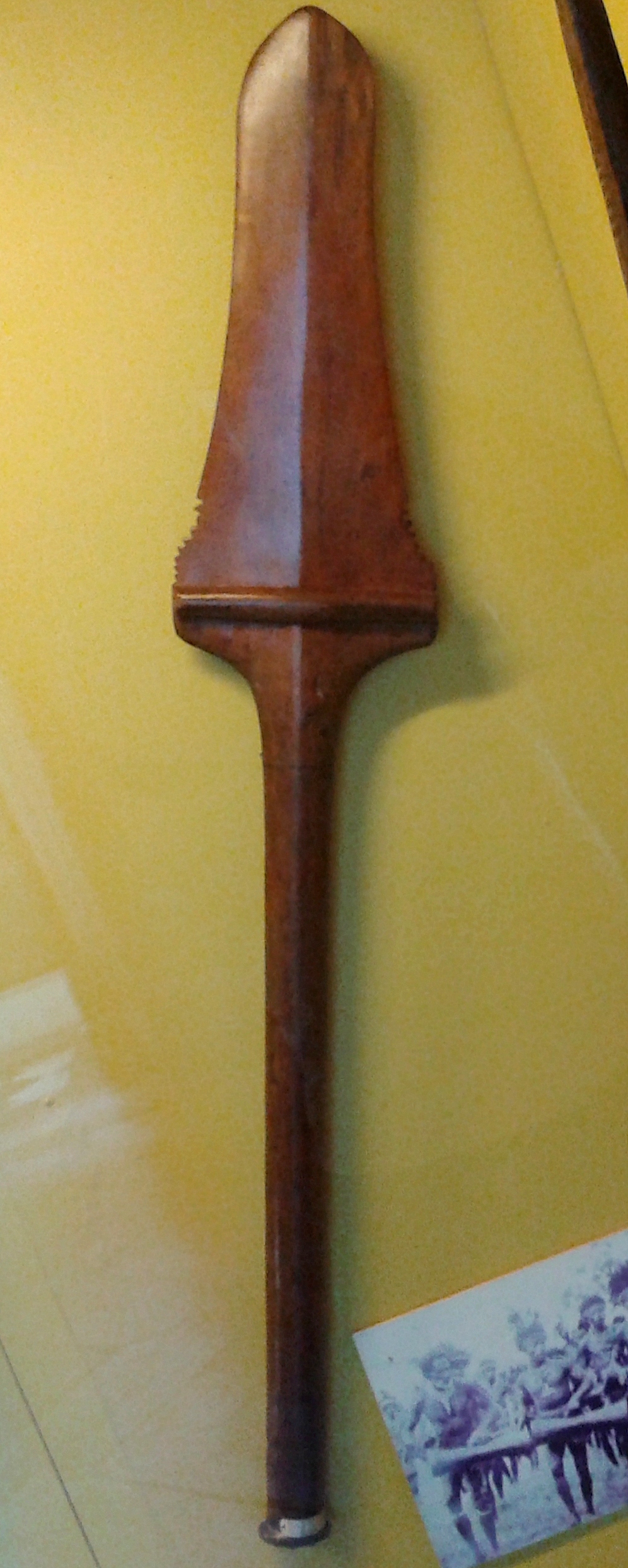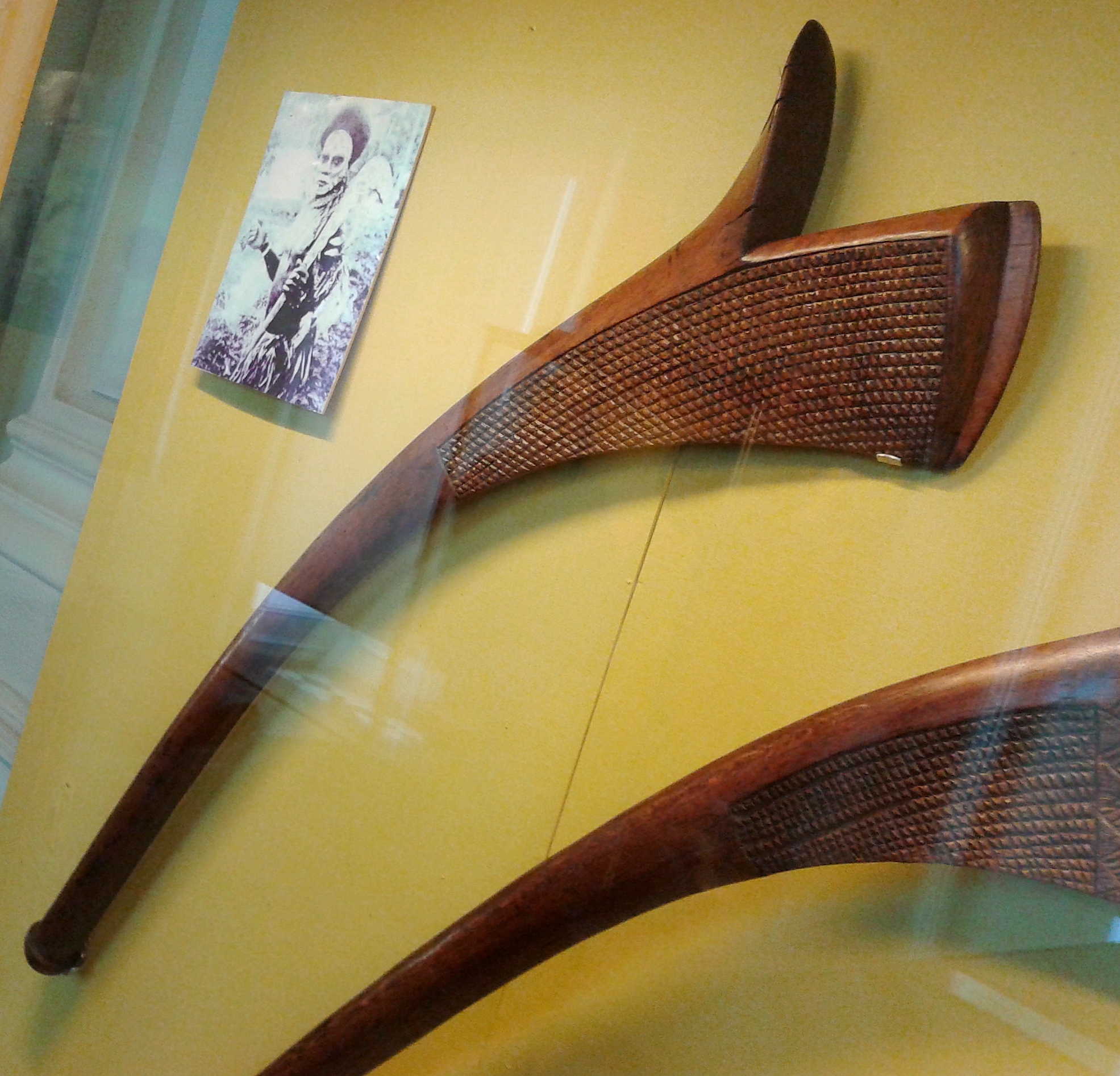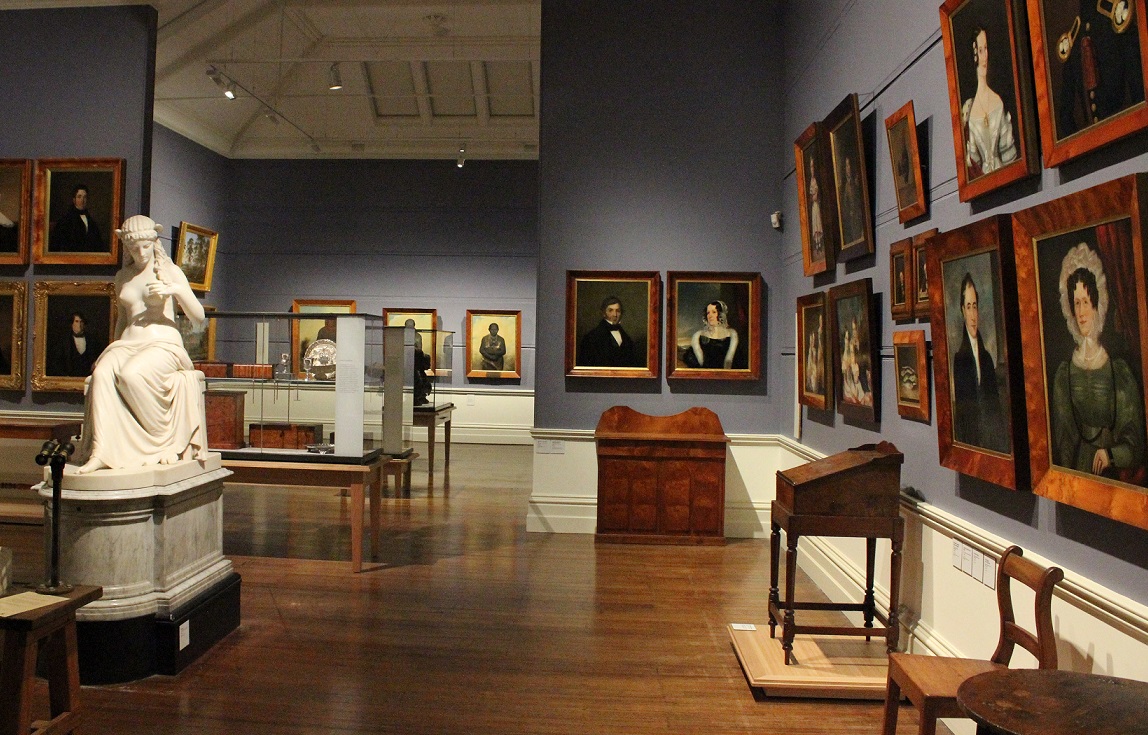|
Bulibuli
A bulibuli or vunikau bulibuli is a Fijian war club. Uses The ''bulibuli'' has a straight and fair long handle (difference with a '' Ula Bulibuli'') and a rounded percussion head. At its end the striking head is rounded and provided with round protuberances, similar to buttons, intended to strengthen the percussion effect. The ''bulibuli'' can be decorated with inlays (shells, etc.).''Bulletin of the Fiji Museum'', Numéros 1 à 2, Fiji Museum, 1973, p.18 Bibliography * Fergus Clunie, ''Fijian weapons and warfare.'' Fiji Museum 2003, . * John Charles Edler, Terence Barrow, ''Art of Polynesia'', Hemmeter Publishing Corporation, 1990. * Jean-Edouard Carlier, ''Archipels Fidji - Tonga - Samoa: La Polynésie Occidentale'', Voyageurs & curieux, 2005. * Rod Ewins, ''Fijian Artefacts: The Tasmanian Museum and Art Gallery Collection'', Tasmanian Museum and Art Gallery, 1982. See also * Totokia * Ula * Gata * Culacula * Sali References Bibliography * John Charles Edler, Terence ... [...More Info...] [...Related Items...] OR: [Wikipedia] [Google] [Baidu] |
Ula (weapon)
The Ula or I Ula Tavatava is a throwing war club from Fiji. Uses in Fiji Usually cut from a hardwood type of iron wood, it has a round end made up of the root knot and is sometimes called "pineapple club" for his particular shape. It can be launched or used as a club.Henry Nottidge Moseley, ''Notes by a Naturalist on the "Challenger": Being an Account of Various observations'', Macmillan and Co, London, 1879, p.338 Some types of Ula have a smooth head. Gallery File:Fijian War Club in Museum of Methodism.jpg, Ula with pineapple ball. File:Ula Fidji.png, Ula with round ball. File:Clubs, Fiji Islands, wood - Pacific collection - Peabody Museum, Harvard University - DSC05762.JPG, Ula collection. Bibliography * John Charles Edler, Terence Barrow, ''Art of Polynesia'', Hemmeter Publishing Corporation, 1990. * Jean-Edouard Carlier, ''Archipels Fidji - Tonga - Samoa: La Polynésie Occidentale'', Voyageurs & curieux, 2005. * Rod Ewins, ''Fijian Artefacts: The Tasmanian Museum and Art Ga ... [...More Info...] [...Related Items...] OR: [Wikipedia] [Google] [Baidu] |
Totokia
The ''totokia'' (also pineapple club or beaked battle hammer) is a type of club or battlehammer from Fiji.Eric Kjellgren, How to Read Oceanic Art' (Metropolitan Museum of Art/Yale University Press, 2014), p. 153. The ''totokia'' was called the "pineapple club" because of the spiked ball behind the weapon's beak.Ron Ewins, "The Perils of Ethnographic Provenance: The Documentation of the Johnson Fiji Collection in the South Australian Museum" in ''Hunting the Collectors: Pacific Collections in Australian Museums'' (eds. Susan Cochrane & Max Quanchi: Cambridge Scholars Publishing, 2007), p. 62. The name is a misnomer; the shape actually is modeled after that of the fruit of the ''pandanus''. The spike ("beak") and head of the weapon were used to puncture the skull of the enemy and crush the head. In addition to its functional use as a weapon of war, ''totokia'' were also status symbols. [...More Info...] [...Related Items...] OR: [Wikipedia] [Google] [Baidu] |
Gata (weapon)
The Gata or Gata waka is a war club from Fiji. Uses in Fiji Usually cut from hardwood, it has a snake or rifle shaped head. The word gata means snake in Fijian language. This weapon can be used for war but also for traditional dances and ceremonies. Its shape is very similar to the ''kiakavo'' used for dancing.Susan Cochrane, Max Quanchi, ''Hunting the Collectors: Pacific Collections in Australian Museums'', p.46 Gallery File:H000293- Club.jpg, Gata File:Two Fijian warriors, photograph by Burton Brothers, 1884.jpg, Fijian warriors, the one on the right with a gata File:Gata waka Fidji 2.jpg, A gata waka club or a kiakavo for dancing Bibliography * John Charles Edler, Terence Barrow, ''Art of Polynesia'', Hemmeter Publishing Corporation, 1990. * Rod Ewins, ''Fijian Artefacts: The Tasmanian Museum and Art Gallery Collection'', Tasmanian Museum and Art Gallery The Tasmanian Museum and Art Gallery (TMAG) is a museum located in Hobart, Tasmania. The museum was established in ... [...More Info...] [...Related Items...] OR: [Wikipedia] [Google] [Baidu] |
Culacula
A Culacula is a paddle war club from Fiji. Uses in Fiji Usually cut from a hardwood type of iron wood, it has a broad blade and was used by chiefs or priests to deflect arrows during war.Susan Cochrane, Max Quanchi, ''Hunting the Collectors : Pacific Collections in Australian Museums'', 2014, p. 4/ref> Bibliography * Fergus Clunie, ''Fijian Weapons & Warfare'', 2003. * Jean-Edouard Carlier, ''Archipels Fidji - Tonga - Samoa: La Polynésie Occidentale'', Voyageurs & curieux, 2005. * Rod Ewins, ''Fijian Artefacts: The Tasmanian Museum and Art Gallery Collection'', Tasmanian Museum and Art Gallery, 1982. References See also * Totokia * Gata Davionte Ganter, known professionally as GaTa, is an American rapper and actor known for his role in the FXX TV series ''Dave'', as well as for being the hype man for rapper Lil Dicky throughout his career as well as on the show. Early life an ... * Sali * Ula * Bulibuli Throwing clubs Clubs (weapon) Primitive weapons Rit ... [...More Info...] [...Related Items...] OR: [Wikipedia] [Google] [Baidu] |
Sali (weapon)
A Sali or Cali or Tebetebe is a war club from Fiji. Uses in Fiji Usually cut from a hardwood type iron wood it is intended for war. It differs from the Gata by the width of its striking head. It is named Sali because of its resemblance to the clawed flower of the plant of the same name (Sali) of the genus Musa of the banana family.Anthony JP Meyer, ''Art océanien'', Könemann, 1995, p. 473 See also * Totokia * Ula * Gata * Culacula * Bulibuli References Bibliography * John Charles Edler, Terence Barrow, ''Art of Polynesia'', Hemmeter Publishing Corporation, 1990. * Rod Ewins, ''Fijian Artefacts: The Tasmanian Museum and Art Gallery Collection'', Tasmanian Museum and Art Gallery, 1982. * ''Bulletin of the Fiji Museum'', Numeros 1–2, Fiji Museum, 1973. * Fergus Clunie,''Fijian weapons and warfare.'' Fiji Museum The Fiji Museum is a museum in Suva, Fiji located in the capital city's botanical gardens, Thurston Gardens. Background The museum is a statutory body and is un ... [...More Info...] [...Related Items...] OR: [Wikipedia] [Google] [Baidu] |
Club From Fiji, Early 19th Century, Metropolitan Museum Of Art, 1985
Club may refer to: Arts, entertainment, and media * ''Club'' (magazine) * Club, a ''Yie Ar Kung-Fu'' character * Clubs (suit), a suit of playing cards * Club music * "Club", by Kelsea Ballerini from the album ''kelsea'' Brands and enterprises * Club (cigarette), a Scottish brand of cigarettes * Club (German cigarette), a German brand of cigarettes * Club Med, a holiday company Food * Club (soft drink) * Club Crackers * Club sandwich * Club (biscuit), a brand of biscuits manufactured by Jacob's (Ireland) and McVitie's (UK) Objects * Club (weapon), a blunt-force weapon * Golf club * Indian club, an exercise device * Juggling club * Throwing club, an item of sport equipment used in the club throw * Throwing club, an alternative name for a throwing stick Organizations * Club (organization), a type of association * Book discussion club, also called a book club or reading circle * Book sales club, a marketing mechanism * Cabaret club * Gentlemen's club (traditional) * Health club ... [...More Info...] [...Related Items...] OR: [Wikipedia] [Google] [Baidu] |
Two Fijian Warriors, Photograph By Burton Brothers, 1884
2 (two) is a number, numeral and digit. It is the natural number following 1 and preceding 3. It is the smallest and only even prime number. Because it forms the basis of a duality, it has religious and spiritual significance in many cultures. Evolution Arabic digit The digit used in the modern Western world to represent the number 2 traces its roots back to the Indic Brahmic script, where "2" was written as two horizontal lines. The modern Chinese and Japanese languages (and Korean Hanja) still use this method. The Gupta script rotated the two lines 45 degrees, making them diagonal. The top line was sometimes also shortened and had its bottom end curve towards the center of the bottom line. In the Nagari script, the top line was written more like a curve connecting to the bottom line. In the Arabic Ghubar writing, the bottom line was completely vertical, and the digit looked like a dotless closing question mark. Restoring the bottom line to its original horizontal ... [...More Info...] [...Related Items...] OR: [Wikipedia] [Google] [Baidu] |
Fiji Museum
The Fiji Museum is a museum in Suva, Fiji located in the capital city's botanical gardens, Thurston Gardens. Background The museum is a statutory body and is under the administration of the Fiji Museum Act and the Preservation of Objects of Archaeological & Palaeontological Interest Act. History The museum was founded in 1904 by a voluntary association - the Friends of Fiji Museum. During the twentieth century its location moved several times before its current location in Thurston Gardens. Its original location was in the old Town Hall. The museum was opened in 1955 by the Governor of Fiji, Sir Ronald Garvey. In 2019 a proposal was put forward that part of the site of Thurston Gardens could be developed by the Indian High Commission; this proposal was opposed by the Director of the Fiji Museum, Sipiriano Nemani. In 2021, former director of the museum, Timaima Sagale Buadromo, had an acquittal for corruption charges and abuse of office reversed, in order to await a new trial ... [...More Info...] [...Related Items...] OR: [Wikipedia] [Google] [Baidu] |
Tasmanian Museum And Art Gallery
The Tasmanian Museum and Art Gallery (TMAG) is a museum located in Hobart, Tasmania. The museum was established in 1846, by the Royal Society of Tasmania, the oldest Royal Society outside England. The TMAG receives 400,000 visitors annually. History The museum was officially created in 1848, though the collections it housed were much created earlier. It merged a number of disparate collections, including that of the Royal Society of Tasmania. The Mechanics' Institution of Hobart, Van Diemen's Land Agricultural Society and Van Diemen's Land Scientific Society had each attempted to found a museum earlier than this date, the most successful of these being the Mechanics' Institution, but little record remains of what happened to these efforts. Sir John Eardley-Wilmot, 1st Baronet, during his period was Lt. Governor of Tasmania, did much of the work that led to the modern museum. The museum was noted as first being an established institution in the 1848 minutes of the Royal Societ ... [...More Info...] [...Related Items...] OR: [Wikipedia] [Google] [Baidu] |
Fiji
Fiji ( , ,; fj, Viti, ; Fiji Hindi: फ़िजी, ''Fijī''), officially the Republic of Fiji, is an island country in Melanesia, part of Oceania in the South Pacific Ocean. It lies about north-northeast of New Zealand. Fiji consists of an archipelago of more than 330 islands—of which about 110 are permanently inhabited—and more than 500 islets, amounting to a total land area of about . The most outlying island group is Ono-i-Lau. About 87% of the total population of live on the two major islands, Viti Levu and Vanua Levu. About three-quarters of Fijians live on Viti Levu's coasts: either in the capital city of Suva; or in smaller urban centres such as Nadi—where tourism is the major local industry; or in Lautoka, where the Sugarcane, sugar-cane industry is dominant. The interior of Viti Levu is sparsely inhabited because of its terrain. The majority of Fiji's islands were formed by Volcano, volcanic activity starting around 150 million years ago. Some geo ... [...More Info...] [...Related Items...] OR: [Wikipedia] [Google] [Baidu] |
Clubs (weapon)
Club may refer to: Arts, entertainment, and media * ''Club'' (magazine) * Club, a ''Yie Ar Kung-Fu'' character * Clubs (suit), a suit of playing cards * Club music * "Club", by Kelsea Ballerini from the album ''kelsea'' Brands and enterprises * Club (cigarette), a Scottish brand of cigarettes * Club (German cigarette), a German brand of cigarettes * Club Med, a holiday company Food * Club (soft drink) * Club Crackers * Club sandwich * Club (biscuit), a brand of biscuits manufactured by Jacob's (Ireland) and McVitie's (UK) Objects * Club (weapon), a blunt-force weapon * Golf club * Indian club, an exercise device * Juggling club * Throwing club, an item of sport equipment used in the club throw * Throwing club, an alternative name for a throwing stick Organizations * Club (organization), a type of association * Book discussion club, also called a book club or reading circle * Book sales club, a marketing mechanism * Cabaret club * Gentlemen's club (traditional) * Health club ... [...More Info...] [...Related Items...] OR: [Wikipedia] [Google] [Baidu] |
Primitive Weapons
Primitive may refer to: Mathematics * Primitive element (field theory) * Primitive element (finite field) * Primitive cell (crystallography) * Primitive notion, axiomatic systems * Primitive polynomial (other), one of two concepts * Primitive function or antiderivative, ''F''′ = ''f'' * Primitive permutation group * Primitive root of unity; See Root of unity * Primitive triangle, an integer triangle whose sides have no common prime factor Sciences * Primitive (phylogenetics), characteristic of an early stage of development or evolution * Primitive equations, a set of nonlinear differential equations that are used to approximate atmospheric flow * Primitive change, a general term encompassing a number of basic molecular alterations in the course of a chemical reaction Computing * Cryptographic primitives, low-level cryptographic algorithms frequently used to build computer security systems * Geometric primitive, the simplest kinds of figures in computer graphics * ... [...More Info...] [...Related Items...] OR: [Wikipedia] [Google] [Baidu] |



